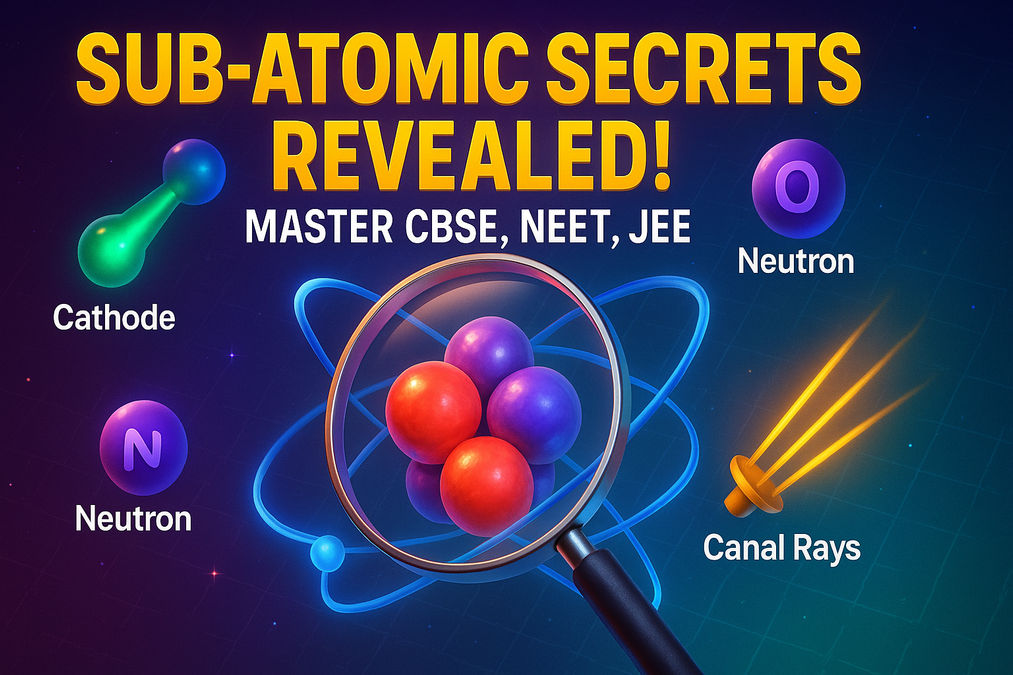Understanding Sub-Atomic Particles for Students
Understanding Sub-Atomic Particles

By Rajesh Jaipal | The Govt Guide
Introduction to Sub-Atomic Particles
Sub-atomic particles—electrons, protons, and neutrons—are the tiny building blocks of atoms, forming the foundation of all matter. For students tackling CBSE, NEET, or JEE exams, mastering these particles is key to understanding chemistry and physics. This colorful guide uses thought boxes to make complex concepts like particle properties, discoveries, and their roles in atomic structure engaging and accessible. Let’s dive into the world of sub-atomic particles!
These tiny particles explain how atoms bond, react, and create everything from water to galaxies!
What Are Sub-Atomic Particles?
Sub-atomic particles are the components of an atom, each with distinct properties:
- ⚡️ Electrons: Negatively charged, with a mass about 1/2000th that of a proton. Discovered by J.J. Thomson in 1897.
- 🔴 Protons: Positively charged, with a mass of 1 unit. Identified through E. Goldstein’s canal rays in 1886.
- 🟣 Neutrons: Neutral, with a mass similar to protons. Discovered by J. Chadwick in 1932.
Electrons are so light that their mass is practically negligible compared to protons and neutrons!
Discovery of Sub-Atomic Particles
The discovery of sub-atomic particles transformed our understanding of atoms:
Electrons
J.J. Thomson’s cathode ray experiments revealed electrons as negatively charged particles present in all atoms, challenging Dalton’s indivisible atom theory.
Protons
E. Goldstein’s observation of canal rays—positively charged radiations in gas discharge tubes—led to the discovery of protons, which have a charge opposite to electrons.
Neutrons
In 1932, J. Chadwick identified neutrons as neutral particles in the nucleus, completing the set of fundamental sub-atomic particles.
Picture scientists in old labs, using crude tools to uncover the atom’s secrets—pure determination!
Role of Sub-Atomic Particles
Each sub-atomic particle plays a critical role in an atom’s structure:
- 🌟 Protons: Define the atomic number, determining the element’s identity.
- 🌟 Neutrons: Contribute to the atom’s mass and stability. Variations create isotopes.
- 🌟 Electrons: Orbit the nucleus in energy levels, influencing chemical bonding.
Protons, neutrons, and electrons work together to keep atoms stable and ready to form molecules!
Atomic Number and Mass Number
The atomic number (Z) is the number of protons, unique to each element. The mass number (A) is the sum of protons and neutrons. For example:
- 🔹 Oxygen: Z = 8 (8 protons), A = 16 (8 protons + 8 neutrons).
- 🔹 Helium: Z = 2 (2 protons), A = 4 (2 protons + 2 neutrons).
Isotopes, like chlorine-35 and chlorine-37, have the same atomic number but different mass numbers due to varying neutrons.
Think of isotopes as twins with different weights—same core, but different neutron counts!
Valency and Chemical Behavior
Valence electrons in the outermost shell determine an atom’s valency—its ability to form bonds. Elements with a full outer shell (e.g., neon with 8 electrons) are stable with zero valency. Others gain, lose, or share electrons to achieve stability. Examples:
- 🔵 Chlorine: 7 valence electrons, valency = 1 (gains 1 electron).
- 🔵 Magnesium: 2 valence electrons, valency = 2 (loses 2 electrons).
Valency is like an atom’s social skills—how many connections it can make to form molecules!
Applications of Sub-Atomic Particles
Sub-atomic particles, especially isotopes, have practical uses:
- 🟠 Uranium isotopes: Power nuclear reactors.
- 🟠 Cobalt isotopes: Used in cancer treatment.
- 🟠 Iodine isotopes: Treat goitre in medical applications.
Sub-atomic particles power energy sources and save lives in medicine—science in action!
Conclusion
Sub-atomic particles—electrons, protons, and neutrons—are the heart of atomic structure. Their discovery and roles explain chemical reactions, nuclear energy, and material properties. With vibrant thought boxes, this guide makes these concepts fun and accessible for students. Master sub-atomic particles to excel in your science exams and unlock the secrets of the microscopic world!
Call to Action
Ready to ace your science exams? Dive into more colorful study guides at The Govt Guide and subscribe for expert tips!
FAQs
1. What are sub-atomic particles?
Sub-atomic particles are electrons, protons, and neutrons that make up an atom.
2. Who discovered the electron?
J.J. Thomson discovered the electron in 1897 through cathode ray experiments.
3. What are canal rays?
Canal rays are positively charged radiations, discovered by E. Goldstein in 1886, leading to the proton’s discovery.
4. Who discovered protons?
Protons were identified through E. Goldstein’s canal rays experiment in 1886.
5. What is the role of neutrons?
Neutrons contribute to an atom’s mass and stability, with variations creating isotopes.
6. How do electrons influence chemical behavior?
Electrons in the outermost shell determine an atom’s valency and reactivity.
7. What is the atomic number?
The atomic number (Z) is the number of protons in an atom’s nucleus, defining the element.
8. What is the mass number?
The mass number (A) is the sum of protons and neutrons in an atom’s nucleus.
9. What are isotopes?
Isotopes are atoms of the same element with the same atomic number but different mass numbers.
10. What are isobars?
Isobars are atoms of different elements with the same mass number but different atomic numbers.
Join the conversation